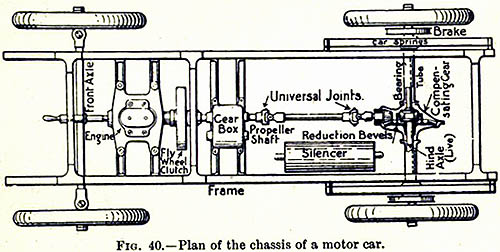How It Works
Today, How It Works. The University of Houston's College of Engineering presents this series about the machines that make our civilization run, and the people whose ingenuity created them.
The world is a scary place when we're at the mercy of machines we don't understand. Small wonder that we're seeing a string book titles for kids: How Stuff Works, How Things Work, How Science Works -- a whole How It Worksseries. Books were different a century ago. Instead of explaining how other people made machines, they more often told us how to build our own motor, radio, or even X-Ray machine.
Now I find the exception in a 1911 book by Edwardian writer on technology, Archibald Williams. Its surprising title is How It Works. Still, although 500 pages deal with the mysteries of existing products, Williams is more concerned with process than product.
Example: Henry Ford had yet to mass-produce automobiles and cars were still playthings of the wealthy. So Williams explains the internal combustion engine -- stroke sequences, valves, ignition, cooling, carburetion, and silencer-- what we call a muffler.

His diagrams show how these elements fit on an auto chassis, which will eventually give the engine its reason to exist. It's a subordinate idea in the text, although the book's cover shows a chauffer opening the hood of an early motor car to show the engine to two boys. Autos were still just improved horse coaches, so that modern version of the coachman, not the owner, does the explaining.
Williams gives great attention to steam, steam boilers, steam turbines, and steam engines. He has chapters on telegraphy, dynamos, and telephones -- on railways and railway signaling. He has one chapter each on optics and optical devices. In a 21st-century flourish he includes details of human blood circulation in his hydraulics chapter.
each on optics and optical devices. In a 21st-century flourish he includes details of human blood circulation in his hydraulics chapter.
He gives us several chapters on sound. They deal with acoustics, the human ear, the complex machinery of pianos and organs, and a wonderfully detailed discussion of the new talking machines -- gramophones and phonographs.
Williams' many other books have dates on their title pages but, some time after 1905, he switched to a publisher who didn't include dates. This tenth edition probably came out in 1911, since Williams has hurriedly added a final chapter on flying machines.
He shows only a few of the most primitive aeroplanes -- the Wright flyer, the monoplane that Bleriot used to cross the English Channel in 1909, and the Farman biplane that won a thousand pound prize for flying from London to Manchester on April 27th, 1910. That chapter also includes one of Williams' few clumsy explanations. He tries to explain how the airfoil shape of a wing lifts the machine into the sky, but he just doesn't get it. Still, it's a valiant attempt to be up-to-date in Kansas City.
This old book leaves us with one last tantalizing mystery. An image on its spine shows the title, How It Works, rising like smoke from a strange circular device that I cannot decipher. Maybe it's meant to be Aladdin's lamp. But it looks to me, for all the world, like a flying saucer from a 1980s science fiction movie.
I'm John Lienhard, at the University of Houston, where we're interested in the way inventive minds work.
A. Williams, How It Works: Dealing in Simple Language with Steam, Electricity, Light, Heat, Sound, Hydraulics, Optics, etc. and with their application to Apparatus in Common Use. Tenth Ed. (London: Thomas Nelson and Sons, ca. 1911).
All images from Williams' book. For more images, click on the links in the text.
